Broadening the minds of Year 6 children through an :拓宽孩子心灵通过6年
儿童发展心理学 英文
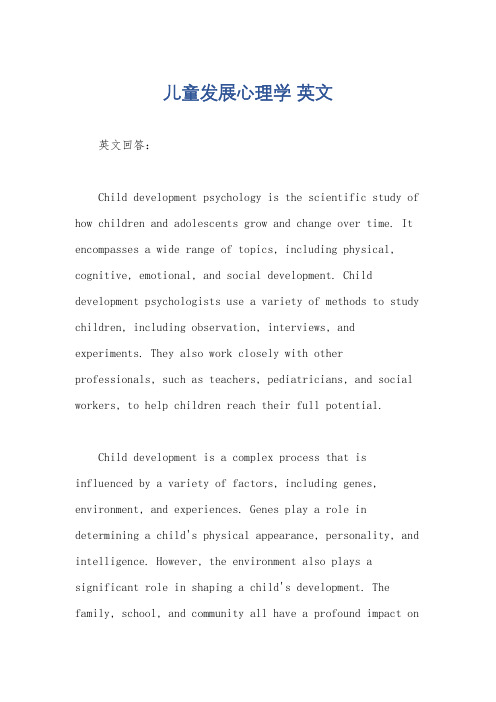
儿童发展心理学英文英文回答:Child development psychology is the scientific study of how children and adolescents grow and change over time. It encompasses a wide range of topics, including physical, cognitive, emotional, and social development. Child development psychologists use a variety of methods to study children, including observation, interviews, and experiments. They also work closely with other professionals, such as teachers, pediatricians, and social workers, to help children reach their full potential.Child development is a complex process that is influenced by a variety of factors, including genes, environment, and experiences. Genes play a role in determining a child's physical appearance, personality, and intelligence. However, the environment also plays a significant role in shaping a child's development. The family, school, and community all have a profound impact ona child's development.Physical development refers to the changes in a child's body over time. These changes include growth in height and weight, as well as changes in body proportions. Physical development also includes the development of motor skills, such as walking, running, and jumping.Cognitive development refers to the changes in achild's mental abilities over time. These changes include the development of language, memory, problem-solving skills, and creativity. Cognitive development is closely linked to physical development, as the brain develops rapidly during childhood.Emotional development refers to the changes in achild's ability to express and manage emotions. These changes include the development of self-awareness, self-regulation, and empathy. Emotional development is closely linked to social development, as children learn to interact with others and form relationships.Social development refers to the changes in a child's ability to interact with others. These changes include the development of friendships, cooperation, and social skills. Social development is closely linked to cognitive and emotional development, as children learn to understand and respond to the emotions of others.Child development psychology is a field that is constantly evolving. As new research is conducted, our understanding of how children develop continues to grow. This research has important implications for parents, teachers, and other professionals who work with children. By understanding how children develop, we can help them reach their full potential and become happy, healthy, and productive members of society.中文回答:儿童发展心理学是科学研究儿童和青少年如何随着时间的推移而成长和变化的学科。
大学英语精读第6册课文全文翻译-中英对照

However, there are signs that much more serious efforts may be mustered in the reasonably near future. Besides, hand in handwith the recent spectacular advances in radio technology, there has been a dramatic increase in the scientific and public respectability of the entire subject of extraterrestrial life. A clear sign of the new attitude is the Viking missions to Mars, whichare to a significantextent dedicated to the search for life on another planet.
儿童健康英语六级阅读练习
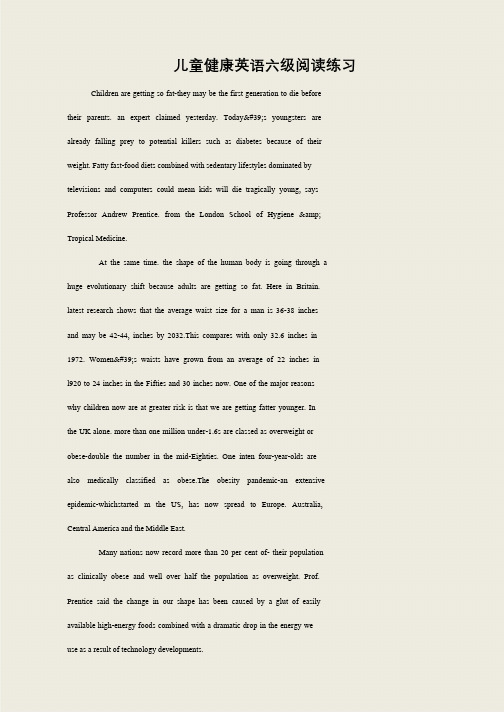
儿童健康英语六级阅读练习Children are getting so fat-they may be the first generation to die before their parents. an expert claimed yesterday. Today's youngsters are already falling prey to potential killers such as diabetes because of their weight. Fatty fast-food diets combined with sedentary lifestyles dominated by televisions and computers could mean kids will die tragically young, says Professor Andrew Prentice. from the London School of Hygiene & Tropical Medicine.At the same time. the shape of the human body is going through a huge evolutionary shift because adults are getting so fat. Here in Britain. latest research shows that the average waist size for a man is 36-38 inches and may be 42-44, inches by 2032.This compares with only 32.6 inches in 1972. Women's waists have grown from an average of 22 inches in l920 to 24 inches in the Fifties and 30 inches now. One of the major reasons why children now are at greater risk is that we are getting fatter younger. In the UK alone. more than one million under-1.6s are classed as overweight or obese-double the number in the mid-Eighties. One inten four-year-olds are also medically classified as obese.The obesity pandemic-an extensive epidemic-whichstarted m the US, has now spread to Europe. Australia, Central America and the Middle East.Many nations now record more than 20 per cent of- their population as clinically obese and well over half the population as overweight. Prof. Prentice said the change in our shape has been caused by a glut of easily available high-energy foods combined with a dramatic drop in the energy we use as a result of technology developments.。
新视野第六册A篇分段
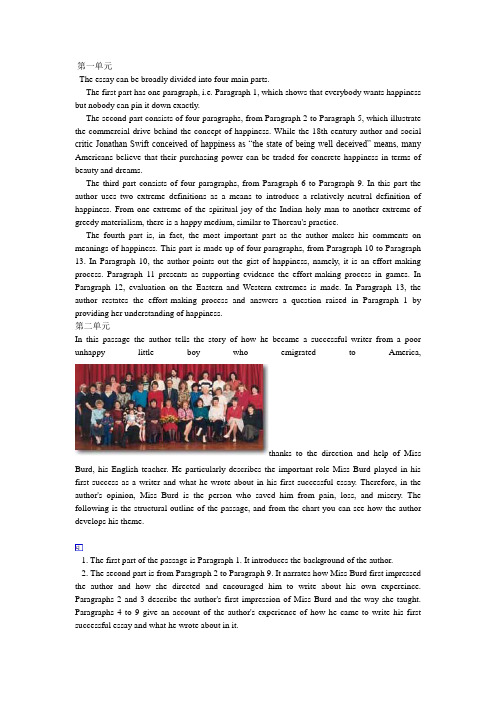
第一单元The essay can be broadly divided into four main parts.The first part has one paragraph, i.e. Paragraph 1, which shows that everybody wants happiness but nobody can pin it down exactly.The second part consists of four paragraphs, from Paragraph 2 to Paragraph 5, which illustrate the commercial drive behind the concept of happiness. While the 18th-century author and social critic Jonathan Swift conceived of happiness as “the state of being well-deceived” means, many Americans believe that their purchasing power can be traded for concrete happiness in terms of beauty and dreams.The third part consists of four paragraphs, from Paragraph 6 to Paragraph 9. In this part the author uses two extreme definitions as a means to introduce a relatively neutral definition of happiness. From one extreme of the spiritual joy of the Indian holy man to another extreme of greedy materialism, there is a happy medium, similar to Thoreau's practice.The fourth part is, in fact, the most important part as the author makes his comments on meanings of happiness. This part is made up of four paragraphs, from Paragraph 10 to Paragraph 13. In Paragraph 10, the author points out the gist of happiness, namely, it is an effort-making process. Paragraph 11 presents as supporting evidence the effort-making process in games. In Paragraph 12, evaluation on the Eastern and Western extremes is made. In Paragraph 13, the author restates the effort-making process and answers a question raised in Paragraph 1 by providing her understanding of happiness.第二单元In this passage the author tells the story of how he became a successful writer from a poor unhappy little boy who emigrated to America,thanks to the direction and help of MissBurd, his English teacher. He particularly describes the important role Miss Burd played in his first success as a writer and what he wrote about in his first successful essay. Therefore, in the author's opinion, Miss Burd is the person who saved him from pain, loss, and misery. The following is the structural outline of the passage, and from the chart you can see how the author develops his theme.1. The first part of the passage is Paragraph 1. It introduces the background of the author.2. The second part is from Paragraph 2 to Paragraph 9. It narrates how Miss Burd first impressed the author and how she directed and encouraged him to write about his own expereince. Paragraphs 2 and 3 describe the author's first impression of Miss Burd and the way she taught. Paragraphs 4 to 9 give an account of the author's experience of how he came to write his first successful essay and what he wrote about in it.3. The third part is Paragraph 10, which shows us the author's path to success through his own efforts.4. The fourth part, Paragraph 11 and Paragraph 12, adds more about Miss Burd, her teaching career and other aspects of her life.5. The last part, i.e. the last two paragraphs, points out the theme that Miss Burd is the author's salvation, she has been and should be honored as a good teacher, and that this article is a tribute to her.第三单元In the reading passage the author narrates a long-lost history about humans in the Amazon: an introduction with a proposition, a history of exploration in the region and an attempt to lift the veil of misunderstanding that shrouds the Amazon Basin, and finally a conclusion that reaffirms the proposition.The first part is Paragraph 1, a general introduction to the passage.The second part, consisting of 3 paragraphs, from Paragraph 2 to Paragraph 4, is about European expeditions in the Amazon Basin from the time of the Renaissance through to the late 17th century.The third part is made up of 5 paragraphs, from Paragraph 5 to Paragraph 9. It is about the mistaken idea that exists in people's minds and about the evidence that is lifting the veil of misunderstanding about the human societies in the Amazon.The fourth part consists of the last two paragraphs: Paragraph 10 and Paragraph 11. It draws a conclusion: the rainforest should no longer be seen as an untouched “paradise” and that knowledge about the past has a vital role to play in planning and decision making for the future.第四单元This reading passage mainly tells a story about the author's sudden encounter in the forest with a mother wolf that had been caught by a trap and how he tried to win her confidence and set her free. It can be divided into three parts:The first part is composed of 4 paragraphs, from Paragraph 1 to Paragraph 4. It relates how the author met by chance with a wolf caught by a hunter's trap while he was prospecting for gold.And it also tells us how, in order to save the wolf from the trap, the author tried to find the mother wolf's babies and then brought them to her.The second part is from Paragraph 5 to Paragraph 7. In this part the author explains how he tried to win the mother wolf's confidence by finding her food and making friends w ith her babies. Having finally won the wolf's confidence, the author succeeded in releasing her from the trap.The third part consists of Paragraph 8 and Paragraph 9. It tells us how the author followed the mother wolf to her clan. There he spent one night peacefully and harmoniously with the wolf clan, which seems completely against nature.第五单元This reading passage offers a general review of genetic engineering achievements to date and the prospective benefits and latent perils. The author holds that what the researchers are plotting is not only a revolution in biology but also in society. The whole passage may be divided into 4 parts. Look at the following chart and you'll find:The first part of the passage is made up of the first 3 paragraphs, and is a general description of the appearance of DNA and its potential function.The second part is made up of 4 paragraphs, from Paragraph 4 to Paragraph 7. This part tells the significance of DNA research and how it is to be applied in medical treatment.The third part consists of Paragraph 8 and Paragraph 9, which gives an account of the dilemma and danger currently posed by the genetic revolution and scientists' worries about the misuse of DNA information.The last part consists of the last 2 paragraphs of the text, i.e. Paragraph 10 and Paragraph 11. This part brings forward people's different opinions of DNA research.第六单元The reading passage focuses on a social phenomenon — jeans and the culture that lies behind it. The passage can be broadly divided into three parts. The first part consists of Paragraphs 1 and 2, dealing with the social position of jeans compared to court dresses in the 19th century. The second part is from Paragraph 3 to Paragraph 8. Paragraph 3 tells us the general meaning jeans gained in the 20th century. Paragraphs 4 to Paragraph 7 deal with the specific meaning jeans expressed for anti-traditional culture in the 1950s, the black rights movement in the mid-1960s, antiwar students during the Vietnam War, feminism in the late 1960s, and fashion in the 1980s. Paragraph 8 is about the overwhelming trend of jeans shown in social life. The third part, Paragraph 9 to Paragraph 11, analyzes how blue jeans display social concepts.In the passage, the author uses many different writing techniques to develop the main ideas. One of the main techniques involved is structuring ideas into paragraphs or visually defined parts.Similarly, in a work of literature the structure is the composition of parts: chapters, episodes, acts, scenes, interludes, climaxes, turning points, stanzas. In writing about structure, you identify the plan of the work and then investigate the logical relationships between parts. The parts of the work are probably related in some or all of the following four ways: the order of chronology, space, suspenseful emotional response, and logical ideas. In this passage, the chronology, or sequence in terms of time, is applied. Most traditional stories, novels, and plays are structured according to time: they begin at the beginning of a sequence of events and move right through to the end. Many also include flashbacks, which serve purposes like g iving background or motivation at an appropriate place. The author of this passage uses common chronological order, which best suits the process of how jeans grow from low beginnings to high fashion.第七单元In this reading passage the author discusses the effects of space travel on the human body. The whole passage can be divided into two sections. The first section is composed of three paragraphs: Paragraph 1 to Paragraph 3, which is a general introduction to the passage. The second section can be subdivided into 4 parts. Paragraph 4 is the first part, referring to weightlessness as a dominant factor which leads to various related responses in human bodies. The second part consists of 4 paragraphs, from Paragraph 5 to Paragraph 8, which is about how space travelers feel in their spacecraft and why this is so. The third part is from Paragraph 9 to Paragraph 12, which deals with the actual consequences weightlessness brings about for human bodies and offers some explanations. Paragraph 13 is the last part, which points out the practical use of this research.。
精读6paper tigers课文翻译
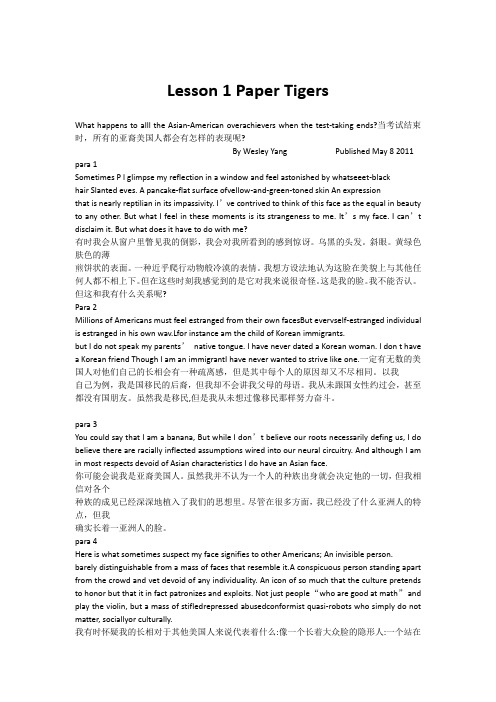
Lesson 1 Paper TigersWhat happens to alll the Asian-American overachievers when the test-taking ends?当考试结束时,所有的亚裔美国人都会有怎样的表现呢?By Wesley Yang Published May 8 2011 para 1Sometimes P l glimpse my reflection in a window and feel astonished by whatseeet-blackhair Slanted eves. A pancake-flat surface ofvellow-and-green-toned skin An expressionthat is nearly reptilian in its impassivity. I’ve contrived to think of this face as the equal in beauty to any other. But what I feel in these moments is its strangeness to me. It’s my face. I can’t disclaim it. But what does it have to do with me?有时我会从窗户里瞥见我的倒影,我会对我所看到的感到惊讶。
乌黑的头发。
斜眼。
黄绿色肤色的薄煎饼状的表面。
一种近乎爬行动物般冷漠的表情。
我想方设法地认为这脸在美貌上与其他任何人都不相上下。
但在这些时刻我感觉到的是它对我来说很奇怪。
这是我的脸。
我不能否认。
但这和我有什么关系呢?Para 2Millions of Americans must feel estranged from their own facesBut evervself-estranged individual is estranged in his own wav.Lfor instance am the child of Korean immigrants.but I do not speak my parents’native tongue. I have never dated a Korean woman. I don t have a Korean friend Though I am an immigrantI have never wanted to strive like one.一定有无数的美国人对他们自己的长相会有一种疏离感,但是其中每个人的原因却又不尽相同。
六年级英语第六单元课文
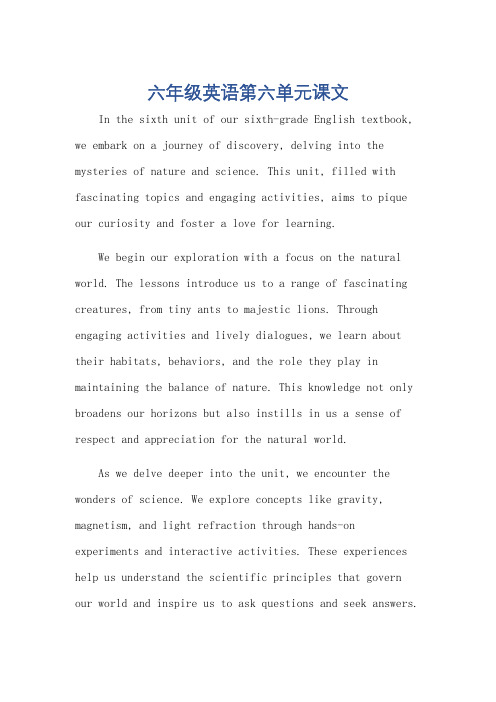
六年级英语第六单元课文In the sixth unit of our sixth-grade English textbook, we embark on a journey of discovery, delving into the mysteries of nature and science. This unit, filled with fascinating topics and engaging activities, aims to pique our curiosity and foster a love for learning.We begin our exploration with a focus on the natural world. The lessons introduce us to a range of fascinating creatures, from tiny ants to majestic lions. Through engaging activities and lively dialogues, we learn about their habitats, behaviors, and the role they play in maintaining the balance of nature. This knowledge not only broadens our horizons but also instills in us a sense of respect and appreciation for the natural world.As we delve deeper into the unit, we encounter the wonders of science. We explore concepts like gravity, magnetism, and light refraction through hands-on experiments and interactive activities. These experiences help us understand the scientific principles that govern our world and inspire us to ask questions and seek answers.The unit also encourages us to think critically and creatively. Through thought-provoking discussions and innovative projects, we are challenged to apply our knowledge and imagination to solve real-world problems.This process not only enhances our cognitive abilities but also cultivates our problem-solving skills and innovative mindset.Moreover, the unit强调团队合作的重要性。
《3—6岁儿童发展指南》一对一倾听的内容
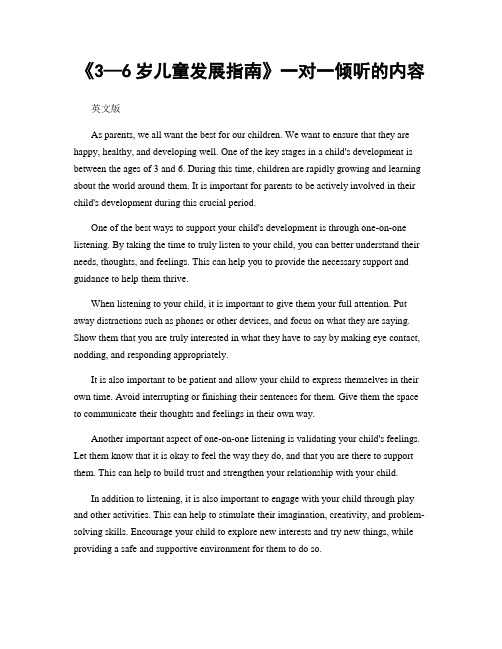
《3—6岁儿童发展指南》一对一倾听的内容英文版As parents, we all want the best for our children. We want to ensure that they are happy, healthy, and developing well. One of the key stages in a child's development is between the ages of 3 and 6. During this time, children are rapidly growing and learning about the world around them. It is important for parents to be actively involved in their child's development during this crucial period.One of the best ways to support your child's development is through one-on-one listening. By taking the time to truly listen to your child, you can better understand their needs, thoughts, and feelings. This can help you to provide the necessary support and guidance to help them thrive.When listening to your child, it is important to give them your full attention. Put away distractions such as phones or other devices, and focus on what they are saying. Show them that you are truly interested in what they have to say by making eye contact, nodding, and responding appropriately.It is also important to be patient and allow your child to express themselves in their own time. Avoid interrupting or finishing their sentences for them. Give them the space to communicate their thoughts and feelings in their own way.Another important aspect of one-on-one listening is validating your child's feelings. Let them know that it is okay to feel the way they do, and that you are there to support them. This can help to build trust and strengthen your relationship with your child.In addition to listening, it is also important to engage with your child through play and other activities. This can help to stimulate their imagination, creativity, and problem-solving skills. Encourage your child to explore new interests and try new things, while providing a safe and supportive environment for them to do so.By actively listening to your child and engaging with them in meaningful ways, you can help to support their development during this crucial stage. Remember, every child is unique and may develop at their own pace. By being patient, understanding, and supportive, you can help your child to reach their full potential.《3—6岁儿童发展指南》一对一倾听的内容作为父母,我们都希望为孩子提供最好的。
新视野第一册unit 6 新年快乐

Ancient:
1)古代的 In ancient Greece 2)古老的,旧的 In Rome, we visited some ancient temples.古庙 Measure:
Measure: 1、量出或者记录 Time is measured by the hour, minute,and second.时间是以 小时、分秒来计算的。 2 度量(大小、长短、数额、程度等) The nurse measured his body temperature. N. 1、措施 We must take measures right away.我们必须马上采取措施。 2、度量单位 An hour is a measure of time. 小时是时间的度量单位
Expert n.专家 内行 She is an expert in cooking Chinese food. 英语方面的专家 Adj.专家的 内行的 She is expert at dealing with this kind of person.
1、The government is going to put up a new shopping center in the neighborhood. 2、One foolish mistake can involve you in a good deal of trouble. 3、He knew the importance of learning from mistakes. 4、Success can not be measured in terms of money.
Drive away 赶走 大风把乌云吹散了 The strong wind drove away the dark clouds away.
儿童心理学 英文
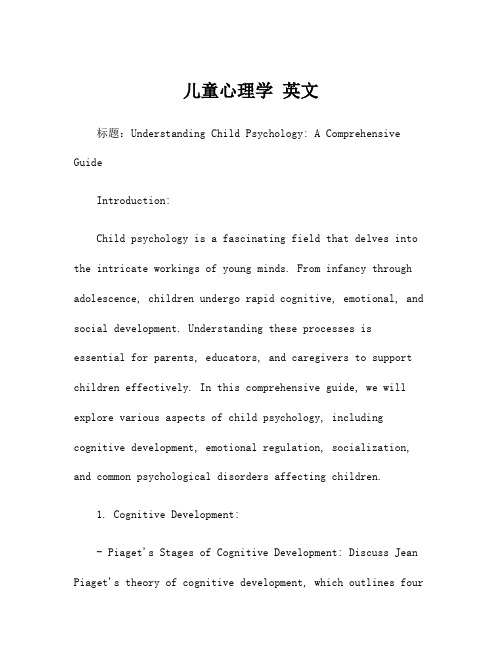
儿童心理学英文标题:Understanding Child Psychology: A Comprehensive GuideIntroduction:Child psychology is a fascinating field that delves into the intricate workings of young minds. From infancy through adolescence, children undergo rapid cognitive, emotional, and social development. Understanding these processes isessential for parents, educators, and caregivers to support children effectively. In this comprehensive guide, we will explore various aspects of child psychology, including cognitive development, emotional regulation, socialization, and common psychological disorders affecting children.1. Cognitive Development:- Piaget's Stages of Cognitive Development: Discuss Jean Piaget's theory of cognitive development, which outlines fourstages—sensorimotor, preoperational, concrete operational, and formal operational—and their implications for understanding how children acquire knowledge and problem-solving skills.- Vygotsky's Sociocultural Theory: Explore Lev Vygotsky's theory, emphasizing the role of social interaction and cultural context in cognitive development, particularly the concept of the zone of proximal development.- Information Processing Theory: Examine how children process, store, and retrieve information, including the development of attention, memory, and executive functionslike planning and problem-solving.2. Emotional Development:- Attachment Theory: Discuss John Bowlby's attachment theory, highlighting the importance of secure attachment in promoting emotional well-being and healthy relationships.- Emotional Regulation: Explore strategies for teaching children to identify and manage their emotions effectively, including techniques such as deep breathing, mindfulness, and cognitive restructuring.- Temperament: Describe the concept of temperament andits influence on children's emotional responses and behavior, including the classifications of easy, difficult, and slow-to-warm-up temperament types.3. Social Development:- Socialization: Explain how children learn social norms, values, and behaviors through interactions with family members, peers, and other social agents, shaping their identity and sense of belonging.- Theory of Mind: Define theory of mind as the ability to understand and attribute mental states to oneself and others, discussing its development in childhood and its role in empathy, perspective-taking, and social relationships.- Peer Relationships: Analyze the significance of peer relationships in children's social development, including the formation of friendships, peer influence, and the impact of peer rejection and bullying.4. Psychological Disorders:- Attention-Deficit/Hyperactivity Disorder (ADHD): Provide an overview of ADHD, including symptoms, prevalence, risk factors, and evidence-based treatments such as behavioral therapy and medication.- Autism Spectrum Disorder (ASD): Explore the characteristics of ASD, including difficulties in social communication and interaction, sensory sensitivities, and repetitive behaviors, along with interventions like applied behavior analysis (ABA) and social skills training.- Anxiety Disorders: Discuss common anxiety disorders in children, such as generalized anxiety disorder (GAD), separation anxiety disorder, and specific phobias, andapproaches to assessment and treatment, including cognitive-behavioral therapy (CBT) and relaxation techniques.Conclusion:Understanding child psychology is crucial for promoting healthy development and well-being in children. By gaining insight into their cognitive, emotional, and social processes, parents, educators, and caregivers can provide the supportand guidance necessary for children to thrive. This comprehensive guide serves as a foundation for further exploration and application of principles in the field ofchild psychology.。
洪恩幼儿英语升级版第六册第三单元
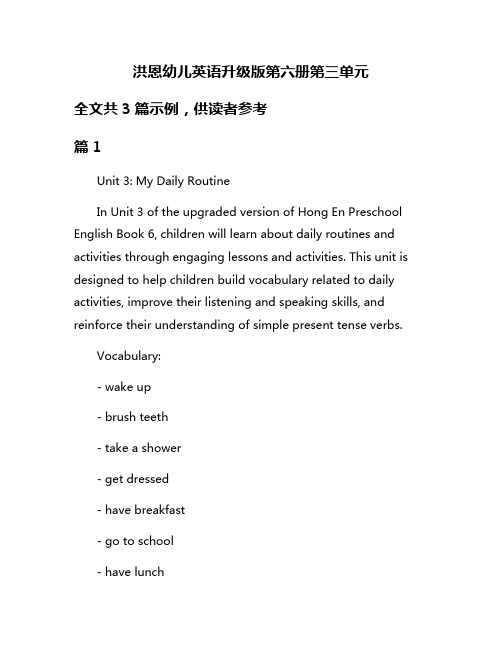
洪恩幼儿英语升级版第六册第三单元全文共3篇示例,供读者参考篇1Unit 3: My Daily RoutineIn Unit 3 of the upgraded version of Hong En Preschool English Book 6, children will learn about daily routines and activities through engaging lessons and activities. This unit is designed to help children build vocabulary related to daily activities, improve their listening and speaking skills, and reinforce their understanding of simple present tense verbs.Vocabulary:- wake up- brush teeth- take a shower- get dressed- have breakfast- go to school- have lunch- do homework- play outside- watch TV- go to bedLesson 1: My Morning RoutineIn this lesson, children will learn about the different activities they do in the morning. They will practice saying sentences like "I wake up at 7 o'clock", "I brush my teeth", and "I take a shower". Through role-playing and interactive activities, children will have the opportunity to use the new vocabulary in context.Lesson 2: My School DayIn this lesson, children will learn about their daily activities at school. They will practice saying sentences like "I go to school at 8 o'clock", "I have lunch at 12 o'clock", and "I do homework in the afternoon". Through group activities and games, children will have fun while learning about their school day routine.Lesson 3: My Evening RoutineIn this lesson, children will learn about the activities they do in the evening. They will practice saying sentences like "I play outside with my friends", "I watch TV before bed", and "I go tobed at 9 o'clock". Through storytelling and creative projects, children will develop their speaking and listening skills while expanding their vocabulary.Overall, Unit 3 of Hong En Preschool English Book 6 provides children with a comprehensive overview of daily routines and activities. By engaging in hands-on activities, games, androle-playing exercises, children will have the opportunity to practice using the new vocabulary in context, improve their communication skills, and gain a better understanding of simple present tense verbs.篇2Unit 3 of the upgraded version of Hoen Yuyer English Book 6 introduces the theme of "Animals in the Wild." In this unit, students will learn about various wild animals, their habitats, characteristics, and behaviors. Through engaging activities, games, songs, and stories, students will develop their English language skills while expanding their knowledge of the natural world.The unit starts with a fun song called "The Animal Boogie," which introduces students to different animals and their movements. This song not only helps students learn newvocabulary but also encourages them to dance and move around, enhancing their physical coordination and expression.Following the song, students will engage in a variety of activities to explore different wild animals. They will learn about the habitats of animals such as lions, tigers, elephants, and giraffes, as well as their diets and behaviors. Through interactive games and role-plays, students will have the opportunity to mimic animal movements and sounds, further reinforcing their understanding of the topic.One of the highlights of this unit is the story "The Lion and the Mouse," a classic fable that teaches students the importance of kindness and cooperation. Through reading and retelling the story, students will not only improve their reading skills but also learn valuable moral lessons.In addition to language and literacy skills, Unit 3 also focuses on building students' cognitive and social-emotional development. Students will participate in activities that promote critical thinking, problem-solving, and teamwork. They will also learn about the importance of conservation and protecting wildlife, fostering a sense of responsibility and empathy towards the environment and its inhabitants.Overall, Unit 3 of the upgraded version of Hoen Yuyer English Book 6 provides a comprehensive and engaging learning experience for young learners. By combining language learning with fun and interactive activities, students will not only improve their English proficiency but also develop a greater appreciation for the natural world and its wonders.篇3Unit 3 of the upgraded version of the sixth book of Hongen Preschool English introduces children to the theme "My Family". In this unit, children will learn vocabulary related to family members, as well as practice speaking and listening skills through various activities and games.The unit begins with a song called "Family Finger" to introduce the concept of family members such as father, mother, brother, and sister. Children will learn to identify and say these family members in English through the catchy and interactive song. This is followed by a story reading activity where children listen to a story about a family and answer questions about the characters in the story.After introducing the vocabulary, children will engage in role-playing activities where they pretend to be different familymembers and interact with each other using the new vocabulary they have learned. This helps children to practice speaking and listening skills in a fun and interactive way.To reinforce the vocabulary, there are also games such as flashcards matching and memory game where children have to match the family members with their names or pictures. These games help children to remember and recall the new words they have learned.In addition to vocabulary and speaking practice, children will also learn about the importance of family and how families can be different but still share similarities. This helps children to develop empathy and understanding towards diverse family structures.Overall, Unit 3 of the upgraded version of the sixth book of Hongen Preschool English provides a comprehensive and interactive learning experience for children to learn about family members and the importance of family. With a combination of songs, stories, role-playing, and games, children are able to engage with the new vocabulary and practice their English skills in a fun and engaging way.。
The Importance of Early Childhood Education

The Importance of Early ChildhoodEducationThe Importance of Early Childhood Education Early childhood education plays a crucial role in shaping a child's future. It is during these formative years that children develop the foundation for their cognitive, social, and emotional skills. The impact of quality early childhood education cannot be overstated, as it sets the stage for a child's lifelong learning and development. In this essay, we will explore the importance of early childhood education from multiple perspectives. From a cognitive perspective, early childhood education provides children with a strong foundation in basic academic skills. Research has shown that children who attend high-quality preschool programs demonstrate higher levels of school readiness, including language and math skills. These early experiences help children develop the necessary cognitive skills to succeed in school and beyond. By providing a stimulating and nurturing environment, early childhood education fosters curiosity, problem-solving abilities, and critical thinking skills. Furthermore, early childhood education promotes social and emotional development. Young children learn to interact with their peers, form friendships, and develop essential social skills such as sharing, taking turns, and resolving conflicts. These early interactions lay the groundwork for healthy relationships andeffective communication later in life. Moreover, early childhood education programs often emphasize the development of emotional intelligence, helping children understand and regulate their emotions. This emotional resilience is crucial for navigating the challenges and stresses of life. From an economic perspective, investing in early childhood education yields significant long-term benefits. Numerous studies have shown that children who participate in high-quality early childhood education programs are more likely to graduate from high school, attend college, and secure higher-paying jobs. The economic returns on these investments are substantial, as individuals with higher levels of education tend to earn higher incomes and contribute more to the economy. Additionally, early childhood education can reduce the need for costly interventions later in life, such as remedial education, special education services, and criminal justiceinvolvement. Moreover, early childhood education has a positive impact on society as a whole. By providing children with a strong educational foundation, we can reduce social inequalities and promote social mobility. Quality early childhood education programs ensure that all children, regardless of their background, have equal opportunities to succeed. This not only benefits individuals and theirfamilies but also strengthens communities and fosters social cohesion. Moreover, early childhood education can help break the cycle of poverty by equippingchildren with the skills and knowledge they need to overcome socioeconomicbarriers. Lastly, from a personal perspective, early childhood education has a profound impact on the lives of children and their families. It provides a safeand nurturing environment where children can learn, explore, and grow. Early childhood education programs often involve parents and caregivers, fosteringstrong partnerships between home and school. This collaboration ensures thatchildren receive consistent support and guidance, maximizing their learning potential. For families, early childhood education offers a sense of security and peace of mind, knowing that their child is in a caring and educational environment. In conclusion, early childhood education is of utmost importance for children's holistic development. It provides a strong foundation for cognitive, social, and emotional skills, setting children up for success in school and beyond. From cognitive development to economic benefits, from societal impact to personal growth, the importance of early childhood education cannot be overstated. It is a crucial investment in our children's future and the future of our society.。
剑桥国际少儿英语kb6原文
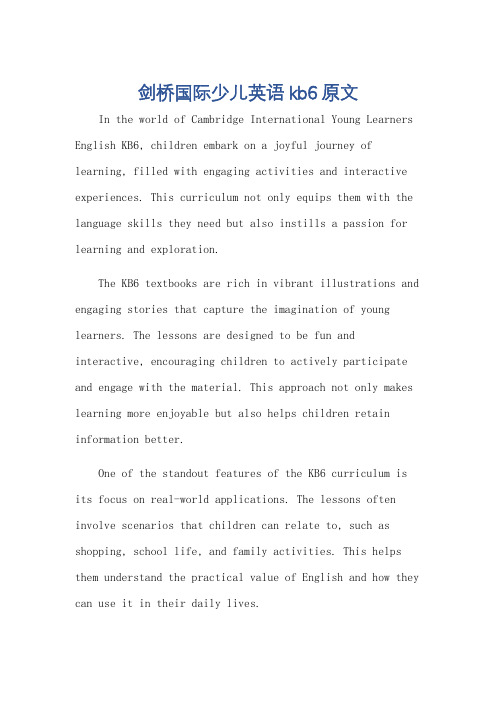
剑桥国际少儿英语kb6原文In the world of Cambridge International Young Learners English KB6, children embark on a joyful journey of learning, filled with engaging activities and interactive experiences. This curriculum not only equips them with the language skills they need but also instills a passion for learning and exploration.The KB6 textbooks are rich in vibrant illustrations and engaging stories that capture the imagination of young learners. The lessons are designed to be fun and interactive, encouraging children to actively participate and engage with the material. This approach not only makes learning more enjoyable but also helps children retain information better.One of the standout features of the KB6 curriculum is its focus on real-world applications. The lessons often involve scenarios that children can relate to, such as shopping, school life, and family activities. This helps them understand the practical value of English and how they can use it in their daily lives.The curriculum also places emphasis on cultural diversity, introducing children to different cultures and traditions from around the world. This broadens their horizons and encourages them to develop a global perspective.The assessment system of KB6 is also noteworthy. It provides a comprehensive evaluation of children's progress, focusing on both their language skills and their ability to apply those skills in real-world situations. This allows teachers to identify areas where children may need additional support and adjust their teaching strategies accordingly.Overall, the Cambridge International Young Learners English KB6 curriculum is a comprehensive and engaging program that fosters a love of learning among young children. It not only equips them with the language skills they need but also instills in them a sense of curiosity and exploration that will benefit them throughout their lives.**剑桥国际少儿英语KB6主题探索:快乐学习的旅程**在剑桥国际少儿英语KB6的世界里,孩子们踏上了一段充满乐趣的学习之旅,其中包含了各种引人入胜的活动和互动体验。
阿德勒经典名言 治愈童年英文版
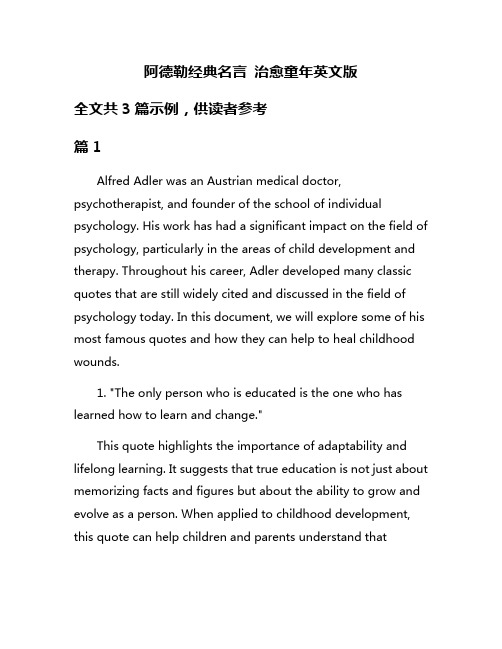
阿德勒经典名言治愈童年英文版全文共3篇示例,供读者参考篇1Alfred Adler was an Austrian medical doctor, psychotherapist, and founder of the school of individual psychology. His work has had a significant impact on the field of psychology, particularly in the areas of child development and therapy. Throughout his career, Adler developed many classic quotes that are still widely cited and discussed in the field of psychology today. In this document, we will explore some of his most famous quotes and how they can help to heal childhood wounds.1. "The only person who is educated is the one who has learned how to learn and change."This quote highlights the importance of adaptability and lifelong learning. It suggests that true education is not just about memorizing facts and figures but about the ability to grow and evolve as a person. When applied to childhood development, this quote can help children and parents understand thatmistakes and failures are not permanent setbacks but opportunities for growth and improvement.2. "The only normal people are the ones you don't know very well."Adler often emphasized the uniqueness of every individual and the importance of embracing differences. This quote challenges the idea of a universal definition of normalcy and encourages acceptance of diversity. When applied to childhood experiences, it can help children and parents recognize that everyone has their own struggles and challenges, and that these differences should be celebrated rather than stigmatized.3. "Trust only movement. Life happens at the level of events, not of words."This quote underscores the importance of action and behavior over words and promises. Adler believed that true change and growth can only occur through concrete actions and experiences. When applied to childhood healing, this quote can help children and parents focus on practical steps and behaviors that can lead to positive outcomes, rather than relying solely on verbal reassurances or intentions.4. "The greater the feeling of inferiority that has been experienced, the more powerful is the urge to conquest and the more violent the emotional agitation."Adler's concept of inferiority complex is central to his theory of individual psychology. This quote highlights the idea that feelings of inadequacy can drive individuals to seek power and control as a way of compensating for their perceived shortcomings. When applied to childhood wounds, this quote can help children and parents understand that behaviors such as defiance, aggression, or control can be rooted in underlying feelings of insecurity and low self-esteem.5. "It is easier to fight for one's principles than to live up to them."This quote emphasizes the challenges of putting beliefs and values into practice. Adler believed that true character is demonstrated through consistent actions and behavior, rather than just words or intentions. When applied to childhood healing, this quote can encourage children and parents to strive for integrity and authenticity in their interactions and relationships, even when faced with obstacles or temptations.In conclusion, Alfred Adler's classic quotes offer valuable insights and guidance for healing childhood wounds. Byembracing principles of adaptability, acceptance, action, and integrity, children and parents can navigate challenges and struggles with courage and resilience. Adler's emphasis on individuality and growth can inspire children to embrace their uniqueness and pursue personal development with confidence and positivity.址篇2[The Classic Quotes of Adler: Healing Childhood 英文版]Alfred Adler, a renowned Austrian psychologist, is known for his profound insights into human behavior and development. His theories have had a lasting impact on the field of psychology, particularly in the realms of individual psychology and child development. Adler believed that the early experiences a person has in childhood play a crucial role in shaping their personality and behavior in adulthood. In this document, we will explore some of Adler's most famous quotes that focus on healing childhood wounds and promoting emotional well-being.1. "The task of childhood is to learn how to cope with the challenges of life. The task of adulthood is to rediscover the joy of living." - Alfred AdlerAdler believed that childhood is a time of exploration and discovery, where children learn how to navigate the world and develop coping mechanisms to deal with life's challenges. However, he also recognized that many adults may have unresolved issues from their childhood that continue to affect their emotional well-being. By acknowledging and addressing these childhood wounds, adults can begin to rediscover the joy and spontaneity of living.2. "We cannot change the past, but we can change our attitude towards it. By doing so, we can heal the wounds of the past and create a brighter future." - Alfred AdlerAdler emphasized the importance of taking responsibility for one's own emotional well-being and actively working towards healing past traumas. He believed that by changing our attitudes towards the past, we can release ourselves from the burden of negative emotions and create a more positive future for ourselves. This quote serves as a reminder that although we cannot change the past, we have the power to shape our own future.3. "Children are not things to be molded, but people to be unfolded." - Alfred AdlerAdler recognized the unique individuality of each child and emphasized the importance of allowing children to develop their own personalities and talents. He believed that children should be encouraged to explore their interests and strengths, rather than conforming to societal expectations or parental pressures. By supporting children in their natural growth and development, we can help them unfold into the best versions of themselves.4. "Understanding a person's childhood is essential to understanding their present behavior. By delving into the past, we can unravel the mysteries of the present." - Alfred AdlerAdler believed that the key to understanding an individual's current behavior lies in examining their experiences and upbringing in childhood. He believed that unresolved issues from childhood can manifest in adulthood as emotional distress or maladaptive behaviors. By exploring and addressing these childhood wounds, we can gain a deeper insight into why a person behaves the way they do and work towards healing and growth.5. "The greatest gift we can give to a child is unconditional love and acceptance. Through love, we can heal the wounds of the past and nurture the potential of the future." - Alfred AdlerAdler believed that love and acceptance are essential components of a child's emotional development and well-being. He emphasized the importance of providing children with a safe and nurturing environment where they can thrive and grow. By offering children unconditional love and support, we can help them heal from past traumas and build the self-confidence and resilience needed to face life's challenges.In conclusion, Alfred Adler's classic quotes on healing childhood wounds and promoting emotional well-being offer valuable insights into the importance of understanding and addressing the impact of childhood experiences on adult behavior. By acknowledging the role that childhood plays in shaping our personalities and behaviors, we can work towards healing past traumas and creating a brighter future for ourselves and future generations. Adler's teachings continue to inspire and guide us in our journey towards emotional well-being andself-actualization.篇3Alfred Adler, the renowned Austrian psychiatrist and founder of the school of Individual Psychology, left behind a legacy of insightful and inspiring quotes that continue to resonate with people all over the world. Known for his emphasis on theimportance of social relationships, the quest for significance, and the unity of mind and body, Adler's words have the power to heal and transform our understanding of childhood experiences. In this article, we will explore some of Adler's classic quotes in English, and reflect on their relevance in the context of childhood healing.1. "It is easier to fight for one's principles than to live up to them."This quote speaks to the idea that our actions often fall short of our beliefs and values. In the context of childhood healing, it reminds us that healing is a journey that requires ongoing effort and commitment. It is one thing to talk about the importance of healing from childhood trauma, but it is quite another to put in the hard work and dedication needed to make real progress. This quote serves as a reminder that the path to healing is not always easy, but it is always worth it.2. "The only normal people are the ones you don't know very well."Adler's emphasis on the uniqueness of each individual is apparent in this quote. He believed that there is no such thing as a "normal" person, and that we all have our own struggles and complexities. In the context of childhood healing, this quotereminds us to approach each person with empathy and understanding, recognizing that everyone's journey to healing is different. By acknowledging and accepting the uniqueness of each individual, we can create a space where healing can truly take place.3. "Courage is not the absence of fear, but the mastery of it."This quote highlights the importance of facing our fears and stepping outside of our comfort zones in order to grow and heal. In the context of childhood healing, it serves as a reminder that healing from trauma requires courage and resilience. It is natural to feel fear and discomfort as we confront our past experiences, but it is through facing these challenges head-on that we can truly begin to heal. This quote encourages us to embrace our fears and take the necessary steps towards healing, knowing that true healing requires courage and determination.4. "Trust only movement. Life happens at the level of events, not of words. Trust movement."Adler's emphasis on action and movement is evident in this quote. He believed that true change and growth come from taking action and making meaningful progress in our lives. In the context of childhood healing, this quote reminds us that healing is not just about talking about our experiences, but aboutactively working towards healing and growth. It is through taking concrete steps and making positive changes in our lives that we can truly begin to heal from childhood trauma. This quote urges us to trust in the power of movement and action, knowing that healing is a dynamic and ongoing process.5. "The individual who is not anchored in himself can still offer his hand to others."This quote speaks to the idea that even when we are struggling with our own healing, we can still offer support and compassion to others. In the context of childhood healing, it reminds us that healing is a collective journey that we can embark on together. By reaching out to others and offering our hand in support, we can create a community of healing and resilience that can help us all on our paths to healing. This quote encourages us to look beyond ourselves and to connect with others in a spirit of compassion and understanding, knowing that together, we can overcome the challenges of our past and create a brighter future.In conclusion, Alfred Adler's classic quotes offer us profound insight and wisdom on the journey of childhood healing. Through his words, we are reminded of the importance of courage, action, empathy, and community in the process ofhealing from childhood trauma. By embracing these principles and embodying these values, we can begin to heal our past wounds and create a future filled with hope, resilience, and growth. Adler's words continue to inspire and empower us on our journey towards healing, reminding us that true healing is possible and within reach for all of us.。
六年级新思维上册英语
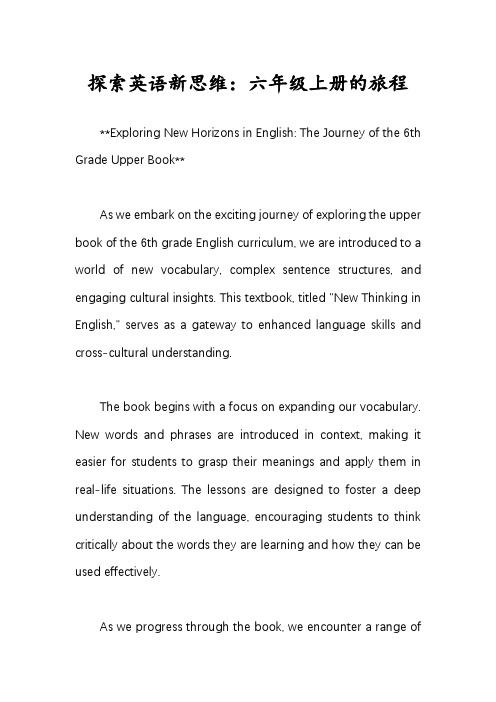
探索英语新思维:六年级上册的旅程**Exploring New Horizons in English: The Journey of the 6th Grade Upper Book**As we embark on the exciting journey of exploring the upper book of the 6th grade English curriculum, we are introduced to a world of new vocabulary, complex sentence structures, and engaging cultural insights. This textbook, titled "New Thinking in English," serves as a gateway to enhanced language skills and cross-cultural understanding.The book begins with a focus on expanding our vocabulary. New words and phrases are introduced in context, making it easier for students to grasp their meanings and apply them in real-life situations. The lessons are designed to foster a deep understanding of the language, encouraging students to think critically about the words they are learning and how they can be used effectively.As we progress through the book, we encounter a range oftopics that are both educational and entertaining. From science experiments to historical events, the lessons are designed to capture the imagination of the young learner. This blend of education and entertainment ensures that students remain engaged and motivated to learn.In addition to the vocabulary and content, the book also focuses on developing grammatical skills. Complex sentence structures and grammatical concepts are introduced gradually, allowing students to build a solid foundation in the language. The exercises and activities provided in the book help students practice these skills and apply them in real-world contexts.One of the most noteworthy features of this book is its emphasis on cross-cultural understanding. Through stories and activities that highlight different cultures, students are able to gain a broader perspective on the world. This cross-cultural aspect not only enhances their language skills but also cultivates a sense of empathy and respect for diverse cultures.The illustrations and graphics throughout the book arevibrant and engaging, further adding to the learning experience. These visuals bring the lessons to life, making them more accessible and enjoyable for students.Overall, "New Thinking in English" for the 6th grade upper book is a comprehensive and engaging resource for developing language skills and cross-cultural understanding. It encourages students to think critically, explore new concepts, and apply their knowledge in real-world situations. As we continue our journey through this book, we are sure to gain not only a deeper understanding of the English language but also a broader perspective on the world.**探索英语新思维:六年级上册的旅程**当我们踏上探索六年级上册英语课程的激动人心的旅程时,我们进入了一个充满新词汇、复杂句子结构和引人入胜的文化洞察力的世界。
两岁以上英文启蒙教育
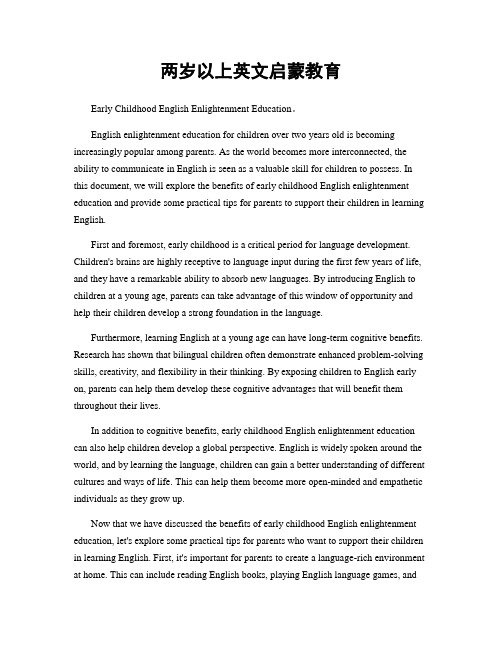
两岁以上英文启蒙教育Early Childhood English Enlightenment Education。
English enlightenment education for children over two years old is becoming increasingly popular among parents. As the world becomes more interconnected, the ability to communicate in English is seen as a valuable skill for children to possess. In this document, we will explore the benefits of early childhood English enlightenment education and provide some practical tips for parents to support their children in learning English.First and foremost, early childhood is a critical period for language development. Children's brains are highly receptive to language input during the first few years of life, and they have a remarkable ability to absorb new languages. By introducing English to children at a young age, parents can take advantage of this window of opportunity and help their children develop a strong foundation in the language.Furthermore, learning English at a young age can have long-term cognitive benefits. Research has shown that bilingual children often demonstrate enhanced problem-solving skills, creativity, and flexibility in their thinking. By exposing children to English early on, parents can help them develop these cognitive advantages that will benefit them throughout their lives.In addition to cognitive benefits, early childhood English enlightenment education can also help children develop a global perspective. English is widely spoken around the world, and by learning the language, children can gain a better understanding of different cultures and ways of life. This can help them become more open-minded and empathetic individuals as they grow up.Now that we have discussed the benefits of early childhood English enlightenment education, let's explore some practical tips for parents who want to support their children in learning English. First, it's important for parents to create a language-rich environment at home. This can include reading English books, playing English language games, andwatching English language videos with their children. By immersing children in English, parents can help them become familiar with the language and develop their listening and speaking skills.Additionally, parents can consider enrolling their children in English language classes or programs specifically designed for young learners. These programs often use interactive, play-based activities to engage children and make learning English fun and enjoyable. By providing children with opportunities to interact with English-speaking teachers and peers, parents can help them build their confidence and fluency in the language.Finally, it's important for parents to be patient and supportive as their children learn English. Learning a new language can be challenging, and children may need time to become comfortable with English. Encouraging children, praising their efforts, and celebrating their progress can help them stay motivated and engaged in their language learning journey.In conclusion, early childhood English enlightenment education offers numerous benefits for children, including cognitive advantages, a global perspective, and enhanced language skills. By creating a language-rich environment at home, exploring English language programs, and providing support and encouragement, parents can help their children develop a strong foundation in English that will benefit them throughout their lives. With the right support and opportunities, children can thrive in their English language learning journey and become confident, proficient English speakers.。
幼儿启蒙教育英文
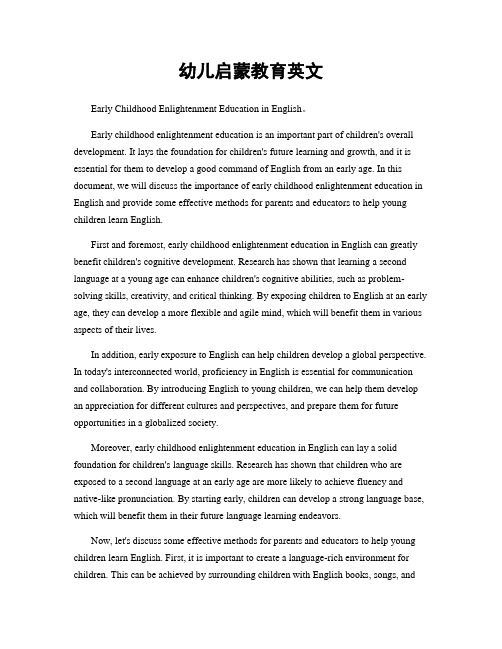
幼儿启蒙教育英文Early Childhood Enlightenment Education in English。
Early childhood enlightenment education is an important part of children's overall development. It lays the foundation for children's future learning and growth, and it is essential for them to develop a good command of English from an early age. In this document, we will discuss the importance of early childhood enlightenment education in English and provide some effective methods for parents and educators to help young children learn English.First and foremost, early childhood enlightenment education in English can greatly benefit children's cognitive development. Research has shown that learning a second language at a young age can enhance children's cognitive abilities, such as problem-solving skills, creativity, and critical thinking. By exposing children to English at an early age, they can develop a more flexible and agile mind, which will benefit them in various aspects of their lives.In addition, early exposure to English can help children develop a global perspective. In today's interconnected world, proficiency in English is essential for communication and collaboration. By introducing English to young children, we can help them develop an appreciation for different cultures and perspectives, and prepare them for future opportunities in a globalized society.Moreover, early childhood enlightenment education in English can lay a solid foundation for children's language skills. Research has shown that children who are exposed to a second language at an early age are more likely to achieve fluency and native-like pronunciation. By starting early, children can develop a strong language base, which will benefit them in their future language learning endeavors.Now, let's discuss some effective methods for parents and educators to help young children learn English. First, it is important to create a language-rich environment for children. This can be achieved by surrounding children with English books, songs, andvideos, and by engaging them in English-speaking activities. By immersing children in English from an early age, they can naturally absorb the language and develop a strong foundation.Second, it is important to make learning English fun and engaging for children. Utilizing games, interactive activities, and storytelling can make the learning process enjoyable for young children. By incorporating play and creativity into English learning, children can develop a positive attitude towards the language and become more motivated to learn.Furthermore, it is important for parents and educators to be patient and supportive throughout the English learning process. Learning a new language can be challenging, and it is important to provide children with encouragement and praise as they progress. By creating a supportive and nurturing environment, children can feel more confident and motivated to continue their English learning journey.In conclusion, early childhood enlightenment education in English is crucial for children's overall development. It can benefit their cognitive development, global perspective, and language skills. By providing a language-rich environment, making learning fun and engaging, and offering patience and support, parents and educators can help young children develop a strong command of English from an early age. It is important to recognize the significance of early childhood enlightenment education in English and to provide children with the necessary resources and support to succeed in their language learning journey.。
新视野英语第一册Unit 6

dump
put down or drop something in a careless way He came in with four shopping bags and dumped
dues
n.应缴款(如俱乐部会费) the official payments that you make to an organization you belong to Members of the society pay $1000 in annual dues.
public works
n.
v. give special classes in sports or a school subject, especially privately, to one person or a small
group
辅导,指导
She coaches students in French, usually for exams.
realise it
I did mention the address but I'm not sure that it registered (with him). I scarcely registered the fact that he was there.
housecoat
n. a woman's garment, usually long and loose, used for informal wear at home.
Broadening the minds of Year 6 children through an :拓宽孩子心灵通过6年精品文档
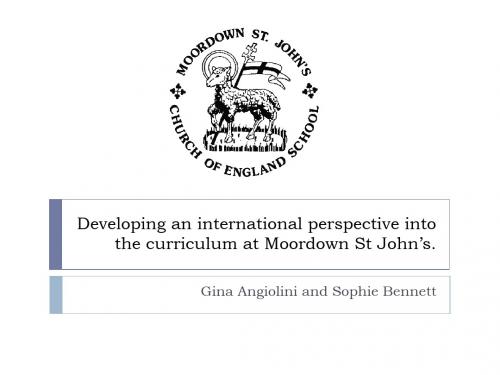
After the project
What we learned
We may have contributed to some of the children’s stereotypes through fundraising days such as Red Nose Day. We have learned to remember to put things into perspective when talking about countries / cultures.
They were then asked to summarise the comments from each country with a single sentence.
The results were very interesting!
Ghana In Ghana they have to work long hours and they are very
They gave some unexpected responses.
From a slide about Scotland
Is that Australia? Did the Scottish discover that place? Did the Scottish supply the building materials?
built. A builder is seen working on the roof. The children could spot some similarities – He has a house He is a builder He is waiting for his house to be built. However when asked what he may be thinking, the children
- 1、下载文档前请自行甄别文档内容的完整性,平台不提供额外的编辑、内容补充、找答案等附加服务。
- 2、"仅部分预览"的文档,不可在线预览部分如存在完整性等问题,可反馈申请退款(可完整预览的文档不适用该条件!)。
- 3、如文档侵犯您的权益,请联系客服反馈,我们会尽快为您处理(人工客服工作时间:9:00-18:30)。
Gina Angiolini and Sophie Bennett
Our aims...
To establish if misconceptions existed regarding other cultures.
They gave some unexpected responses.
From a slide about Scotland
Is that Australia? Did the Scottish discover that place? Did the Scottish supply the buige stereotypes. To develop an international learning approach. To develop a system of peer coaching. To support an open minded approach to cross cultural
To always focus on similarities as well as differences. We enjoyed taking part in Peer Coaching. It enabled us to feel
confident in what we were doing and helped us to share good practice between colleagues. Observing each other’s good practice in a supportive way. Even though the children have participated in topic learning about other cultures, they still held inaccurate existing ideas about them ( had we promoted cultural misunderstanding and stereotypes?) There is a need to develop international learning across the school.
They found it difficult to relate to the everyday lives of children in the other cultures e.g assuming everyone in Spain is on holiday all the time.
They assumed that they were very knowledgeable about the cultures that we looked at.
They understood the term stereotype. They recognised that the media manipulates us all. They stopped making sweeping generalisations.
After the project
Korea Korea is a very polluted country.
Scotland In Scotland they wear kilts and play the bag pipes for entertainment.
The children were then shown some pictures of each country.
From a slide about Ghana
That could be England. Look at all of the cars. Are their houses made out of wood or brick?
Finding similarities
We then talked about finding similarities. Children initially found this difficult. In a picture of a Ghana a man is waiting for his house to be built. A builder
studies.
Previous learning
Our Year 6 children had:
- Participated in a topic about Uganda - Made links with Uganda through a business enterprise
project - Participated in a whole school Africa project - Participated in European day
Stereotypes.
We then asked the children what
a stereotype was.
They responded well to a game which enabled them to recognise that stereotypes may also be made about us eg if we like reading or wear a hoody.
What we did
We wanted to establish if misconceptions existed and give the children an opportunity to realise this for themselves.
We developed a sequence of lessons focussing on developing an understanding of the typical day of a 10 year old in another culture.
During the topic, children began to realise about the role of the media and how misconceptions can be assumed. They reflected about charity adverts and discussed shock tactics which enabled them to see how they had easily assumed these stereotypes.
They were then asked to summarise the comments from each country with a single sentence.
The results were very interesting!
Ghana In Ghana they have to work long hours and they are very poor.
What we learned
We may have contributed to some of the children’s stereotypes through fundraising days such as Red Nose Day. We have learned to remember to put things into perspective when talking about countries / cultures.
The countries were Spain, Scotland, Ghana, Italy and Korea.
The children added to a mindmap of each country, writing down what they knew about each one.
We highlighted reflective practice, particularly on acknowledging similarities as well as differences.
We used collaborative learning methods.
We promoted independent research / child initiated research using different mediums (internet, books, personal life experiences, video clips).
They judged everything by appearance.
During the topic
As the topic progressed the children developed an open minded approach to other cultures.
They realised that there were many similarities as well as differences.
Before the topic
The children found it difficult to find similarities between cultures.
They made generalisations about other cultures based on narrow media portrayal.
Encouraged children and staff with a first hand knowledge of other cultures to share their experiences.
Initial assessment
We chose 5 countries for the children to research as part of our topic - national, European, African and Asian countries.
